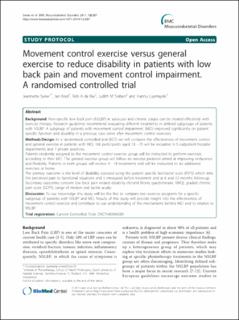Please use this identifier to cite or link to this item:
https://doi.org/10.21256/zhaw-1930Full metadata record
| DC Field | Value | Language |
|---|---|---|
| dc.contributor.author | Saner-Bissig, Jeannette | - |
| dc.contributor.author | Kool, Jan | - |
| dc.contributor.author | de Bie, Rob A. | - |
| dc.contributor.author | Sieben, Judith M. | - |
| dc.contributor.author | Luomajoki, Hannu | - |
| dc.date.accessioned | 2018-04-05T11:19:09Z | - |
| dc.date.available | 2018-04-05T11:19:09Z | - |
| dc.date.issued | 2011 | - |
| dc.identifier.issn | 1471-2474 | de_CH |
| dc.identifier.uri | https://digitalcollection.zhaw.ch/handle/11475/4848 | - |
| dc.description.abstract | Background: Non-specific low back pain (NSLBP) in subacute and chronic stages can be treated effectively with exercise therapy. Research guidelines recommend evaluating different treatments in defined subgroups of patients with NSLBP. A subgroup of patients with movement control impairment (MCI) improved significantly on patient specific function and disability in a previous case series after movement control exercises. Methods/Design: In a randomised controlled trial (RCT) we will compare the effectiveness of movement control and general exercise in patients with MCI. 106 participants aged 18 -75 will be recruited in 5 outpatient hospital departments and 7 private practices. Patients randomly assigned to the movement control exercise group will be instructed to perform exercises according to their MCI. The general exercise group will follow an exercise protocol aimed at improving endurance and flexibility. Patients in both groups will receive 9-18 treatments and will be instructed to do additional exercises at home. The primary outcome is the level of disability assessed using the patient specific functional scale (PSFS) which links the perceived pain to functional situations and is measured before treatment and at 6 and 12 months follow-up. Secondary outcomes concern low back pain related disability (Roland Morris questionnaire, RMQ), graded chronic pain scale (GCPS), range of motion and tactile acuity. Discussion: To our knowledge this study will be the first to compare two exercise programs for a specific subgroup of patients with NSLBP and MCI. Results of this study will provide insight into the effectiveness of movement control exercise and contribute to our understanding of the mechanisms behind MCI and its relation to NSLBP. | de_CH |
| dc.language.iso | en | de_CH |
| dc.publisher | BioMed Central | de_CH |
| dc.relation.ispartof | BMC Musculoskeletal Disorders | de_CH |
| dc.rights | http://creativecommons.org/licenses/by/2.0/ | de_CH |
| dc.subject | Movement Control | de_CH |
| dc.subject | Tactile acuity | de_CH |
| dc.subject | General exercise | de_CH |
| dc.subject | Chronic pain grade | de_CH |
| dc.subject | Patient specific functional scale | de_CH |
| dc.subject.ddc | 617.5: Orthopädische Chirurgie | de_CH |
| dc.title | Movement control exercise versus general exercise to reduce disability in patients with low back pain and movement control impairment : a randomised controlled trial | de_CH |
| dc.type | Beitrag in wissenschaftlicher Zeitschrift | de_CH |
| dcterms.type | Text | de_CH |
| zhaw.departement | Gesundheit | de_CH |
| zhaw.organisationalunit | Institut für Physiotherapie (IPT) | de_CH |
| dc.identifier.doi | 10.21256/zhaw-1930 | - |
| dc.identifier.doi | 10.1186/1471-2474-12-207 | de_CH |
| zhaw.funding.eu | No | de_CH |
| zhaw.issue | 207 | de_CH |
| zhaw.originated.zhaw | Yes | de_CH |
| zhaw.publication.status | publishedVersion | de_CH |
| zhaw.volume | 12 | de_CH |
| zhaw.publication.review | Peer review (Publikation) | de_CH |
| Appears in collections: | Publikationen Gesundheit | |
Files in This Item:
| File | Description | Size | Format | |
|---|---|---|---|---|
| 2011_Saner-Bissig_Movement control exercise_BMC Musculoskeletal Disorders.pdf | 351.87 kB | Adobe PDF |  View/Open |
Show simple item record
Saner-Bissig, J., Kool, J., de Bie, R. A., Sieben, J. M., & Luomajoki, H. (2011). Movement control exercise versus general exercise to reduce disability in patients with low back pain and movement control impairment : a randomised controlled trial. BMC Musculoskeletal Disorders, 12(207). https://doi.org/10.21256/zhaw-1930
Saner-Bissig, J. et al. (2011) ‘Movement control exercise versus general exercise to reduce disability in patients with low back pain and movement control impairment : a randomised controlled trial’, BMC Musculoskeletal Disorders, 12(207). Available at: https://doi.org/10.21256/zhaw-1930.
J. Saner-Bissig, J. Kool, R. A. de Bie, J. M. Sieben, and H. Luomajoki, “Movement control exercise versus general exercise to reduce disability in patients with low back pain and movement control impairment : a randomised controlled trial,” BMC Musculoskeletal Disorders, vol. 12, no. 207, 2011, doi: 10.21256/zhaw-1930.
SANER-BISSIG, Jeannette, Jan KOOL, Rob A. DE BIE, Judith M. SIEBEN und Hannu LUOMAJOKI, 2011. Movement control exercise versus general exercise to reduce disability in patients with low back pain and movement control impairment : a randomised controlled trial. BMC Musculoskeletal Disorders. 2011. Bd. 12, Nr. 207. DOI 10.21256/zhaw-1930
Saner-Bissig, Jeannette, Jan Kool, Rob A. de Bie, Judith M. Sieben, and Hannu Luomajoki. 2011. “Movement Control Exercise versus General Exercise to Reduce Disability in Patients with Low Back Pain and Movement Control Impairment : A Randomised Controlled Trial.” BMC Musculoskeletal Disorders 12 (207). https://doi.org/10.21256/zhaw-1930.
Saner-Bissig, Jeannette, et al. “Movement Control Exercise versus General Exercise to Reduce Disability in Patients with Low Back Pain and Movement Control Impairment : A Randomised Controlled Trial.” BMC Musculoskeletal Disorders, vol. 12, no. 207, 2011, https://doi.org/10.21256/zhaw-1930.
Items in DSpace are protected by copyright, with all rights reserved, unless otherwise indicated.